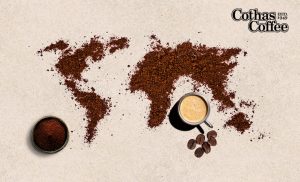Welcome, coffee lover, to the world of coffee by Cothas. Before we delve further into this aromatic heaven, we suggest you grab a cup of your favorite coffee and settle down.
Take a deep breath of that aroma from your coffee and savour each sip and imagine. What if humans had never discovered coffee? It’s indeed quite a dreadful thought to wake up to every morning. If there is anyone who has to be thanked for making this splendid discovery, it was an Arab goatherd in Ethiopia who came upon his flock of goats relishing on some strange berries and they actually seemed to be enjoying it to a great extent. He could not wait to share this wonderful discovery with his Arab buddies and from there, history says it spread all over the Arab world and subsequently to all around the world. Soon every consumer began to cherish the exhilarating feeling the drink offered irrespective of their geographical location.
India was acquainted to coffee in the 17th century when a monk named Baba Budan managed to smuggle seven coffee beans from Yemen, and planted them in Chikmagalur district of Karnataka. By the turn of the 18th century, the British settlers had converted most of the farmlands into commercial coffee plantations in and around Chikmagalur. Today, India shares the 6th spot along with Honduras among the world’s highest coffee producers, while Brazil stays on top. Karnataka, Tamil Nadu, and Kerala are the highest coffee producers in India with Karnataka taking the lion’s share.
Getting back to the delicious drink at hand, did you know that as coffee is roasted, a distinct aroma emerges which again is one of the major factors for all of us to fall in love with coffee over and over again - and that substance responsible for this irresistible aroma is called caffeol. The ensuing chemical reaction contains a huge participant list of over 850 volatile compounds each playing their parts to perfection.
Coffee is said to contain two categories of acids: organic and chlorogenic. During the roasting phase, the chlorogenic acids break down to form quinic acid and caffeic acid, both of which attribute to the bitter and astringent flavour of coffee, with the flavour directly proportional to the amount of roasting.
Now that you are almost at the end of your cup, you must be feeling a lot more relaxed and energized by now. The caffeine present in coffee interferes with your neurotransmitters and blocks a neurochemical called adenosine. Our body, as a defence mechanism, releases dopamine and glutamate, the two of which are responsible for inducing a feel-good sensation in our body, something akin to what you’re experiencing right now.
Last sip: Coffee has been used medicinally and recreationally for ages all over the world. Cheers to all the good times and happy moments this wonder drink has given us. Hope you enjoyed your drink!
REFERENCES:
2.https://www.britannica.com/topic/coffee#ref66600
3.https://www.zmescience.com/science/domestic-science/coffee-chemistry-maillard-reaction/


